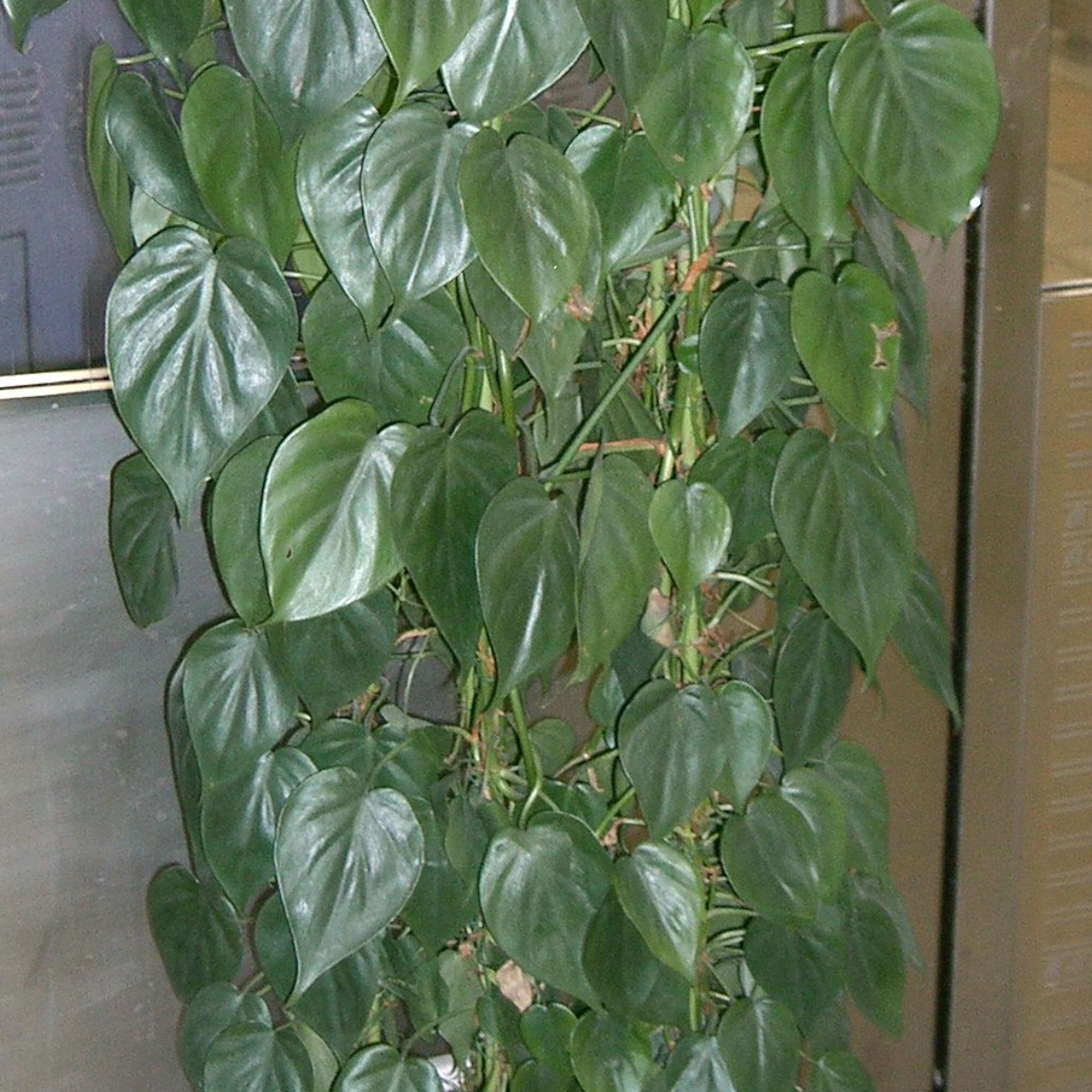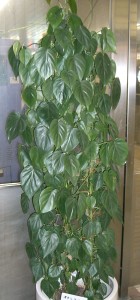Common name: Heartleaf Philodendron, Heart-leaf Ivy, Philodendron, Sweetheart Plant
Family: Araceae
Synonym: Philodendron cordatum
Philodendron cuspidatum
Philodendron micans
Philodendron oxycardium
Philodendron scandens
Distribution and habitat:Philodendron hederaceum is a hemiepiphyte vine native to Central America and the Caribbean. Most of these plants occur in humid tropical forests, but can also be found in swamps and on river banks, roadsides and rock outcrops. Philodendron hederaceum are often found clambering over other plants or climbing the trunks of trees with the aid of aerial roots.
Description: Philodendron hederaceum is an evergreen climber growing to 36m (1020 feet), with heart-shaped glossy leaves 10cm (4 inch) long and 8cm (3 inch) wide with 5-8cm (2-3 inch) long leaf-stalk. The leaves have acutely pointed tips. The leaves look slightly brownish and almost transparent when they are new, but they quickly become deep green as they grow to maturity. Occasionally spathes of white flowers appear in mature plants.
Philodendron means "tree loving" and many of these species have two growth phases, a juvenile form and a mature form, which often look very different as leaf size and shape. Container-grown specimens almost always stay in the juvenile phase.
Houseplant care: Philodendron hederaceum is one of the easiest of all house plants to grow. It is very vigorous grower that can take a wide range of conditions.
Experienced growers recommend regular pinching out of the growing tips in order to make the Philodendron hederaceum bushy. Otherwise, the stems tend to grow too long giving the plant a skimpy look.
Try to pinch close to the node because any bare stem that is left will die, and the node will not grow a new stem. Use sharp scissors or pruners.
Water: During the active growth period water moderately, giving enough at each watering to moist the potting mixture throughout and allowing the top centimeter (0.4 inch) of so of the potting mixture to dry out between waterings. During the sort midwinter rest period water only enogh to keep the entire mixture from drying out completely.
Philodendron hederaceum is not terribly set back by dry indoor air, but moist air does seem to lead to larger leaves and faster growth. Mist the plant to increase the humidity. It is best to use purified water, minerals in tap water build up on the leaves.
Light:Philodendron hederaceum will tolerate low light, for quite a long time, though like most "low-light" plants, it will do better if given bright indirect light.
Temperature: Philodendron hederaceum will grow well in normal to warm indoor temperatures 24-27C (75-80F). Philodendron hederaceum cannot tolerate temperatures which drop below about 13C (55F).
Fertilise: Throughout the months while the Philodendron hederaceum is actively growing apply standard liquid fertiliser once every two weeks.
Potting and repotting: Like other houseplants, philodendrons benefit from repotting to a larger container when they become root bound and outgrow the original pot.
Use a combination of half soil-based potting mixture and half leaf mould or coarse peat moss. Move Philodendron hederaceum into container one size larger only when their roots have completely filed the current one. Do this at any time of year except during the short rest period. After the maximum convenient pot size has been reach (probably about 25-30cm (10-12 inch)), an annual spring top-dressing with fresh potting mixture will help to keep the plat healthy.
Use a container with drainage holes to prevent root rot. If a decorative container without drainage is used, then use it as a cachepot - just slip the plain nursery pot into the cachepot. It is recommended to cover the bottom of a cachepot with pebbles to keep the plant above the drainage water.
Propagation: Cutting and layering are popular methods of Philodendron hederaceum propagation. Try propagating them during the growing season. Along the vine branches there are small brown nubs formed where the leaves meet the stem. These nubs, when in contact with soil or water, will grow roots. There are many ways to propagate this plant, the easiest being to cut a branch just below a root-nub and place it in water with a few pieces of horticultural charcoal to reduce the likelihood of rot. As soon as new leaf growth is noted, pot in rich soil. The plant can also be propagated within its own pot by pinning vines at the root-nub to the soil with hairpins or bent wire. The root-nub in contact with the soil will sprout new roots shortly. When sections of Philodendron hederaceum are rooted, the plant will greatly benefit from misting several times a day (with purified water, if possible).
Problems: No serious insect or disease problems. Watch for aphids, spider mites, mealybugs and scale. Leaf spots may occur. Root rot can occur in overly moist soils.
Small leaves or long spaces between leaves show that the plant is not getting enough light.
Treatment: Move the Philodendron hederaceum plant to a brighter location, but not into direct sun.
Interesting facts: There is about 200 year old discussion going on about the true name of this plant. There are still references toPhilodendron oxycardium, Philodendron scandens and Philodendron cordatum in houseplant books etc., but Philodendron hederaceum is the actual correct name. The reason for all the names, in part, is that the plant has a really variable habit, depending on its age and growing conditions, so specimens collected at different times and places may differ in size, habit, coloration and texture.
Toxicity: Parts of the plant are known to contain calcium oxalate crystals in varying concentrations. Although the plant is known to be toxic to mice and rats, the current literature is conflicting with regards to its toxicity in cats. Its possible toxic effects on humans are currently unknown although likely very mild if not harmless.
Uses:Known for their ability to thrive in low-light conditions typical of many homes and offices,Philodendron hederaceum plants are often grown for their lush foliage. It can be grown as a climbing or training specimen depending on whether its long stems are trained up supports or are allowed to trail over the rims of the pots or hanging baskets.
Philodendron hederaceum as a climbing species is usually tried to a stake inserted into the potting mixture for support. For best results, dress the stake in sphagnum moss until form a 5-8cm (2-3 inch) thickness over the full length of the stake above the potting mixture level. Alternatively, nail a piece of rough-textured cork-bark to the stake. The sphagnum moss or cork-bark being used must then be sprayed with water at least once a day. Doing this it will stimulate the aerial roots of the Philodendron hederaceum to get a firm hold on this support. Be sure that the support is tall enough to accommodate the eventual total growth of the plant.
In the tropical and humid subtropical regions Philodendron hederaceum can be used as a ground cover or on arbors or trellises for dependable, soft green color and a tropical look, particularly around patios, windowsills and pools.
Philodendron hederaceum is also noted by NASA among the best types of houseplants for removing formaldahyde, especially higher concentrations. It is capable to absorb between 80 and 90% of the formaldehyde present in water-based paint, roofing felt or insulation material, glues in fitted carpets or even laminated wood floors!
SUMMARY:
CHARACTERISTICS:
Foliage green
Shape climbing and trailing
Height: 36m (1020 feet)
PROPER CARE:
Watering in rest period sparingly
Watering in active growth period moderately
Light bright filtered
Temperature in rest period min 13C max 24C (55-75F)
Temperature in active growth period min 13C max 24C (55-75F)
Humidity low
Hardiness zone: 10a-11
Begonia propagation f...
Essential Nutrients f...
Portulacaria afra
Tillandsia recurvata
Tillandsia stricta
Columnea microphylla
Clivia miniata
Cleyera japonica
Clerodendrum thomsoni...
Cleistocactus strausi...



